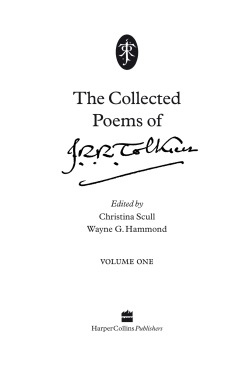Tolkien’s Collected Poems Update
Our thanks to all who have written to us with congratulations and set a new record for views of this blog. News of the Collected Poems has caused not a little excitement. It has also led to not a few questions, chief among which has been: What will the book include? Will it have the complete Lay of the Fall of Gondolin? Will it have Tolkien’s verse translation of Beowulf? Will it have his rumoured bestiary poems about the Fox and the Unicorn? And especially (if very curiously), will it have The Complaint of Mîm the Dwarf, which so far has been published only in German translation?
We regret that we can say only so much about the contents at this time, beyond what we already have – it’s up to our publisher, and to the Tolkien Estate, to decide how much publicity to release, what, and when. But we can say that almost any poem a potential reader can name is likely to be present in the book, except for most of those in The Hobbit and The Lord of the Rings, as we earlier made clear. The Bookseller magazine unfortunately took liberties with HarperCollins’ press release, declaring the Collected Poems to be ‘the first time all the author’s poems will appear in one volume’: it won’t be quite complete, nor will it will be only one volume.
There will be an American edition, from William Morrow, which should be identical to the copies issued by HarperCollins U.K. except for the imprint. This has been announced for 17 September, five days later than the U.K. release on 12 September, with the list price $125. We’ve seen some complaints that the U.K. list price of £90 is steep, but that is for three thick volumes (and a box), after all, and before any bookseller’s discount. Another forthcoming book related to Tolkien we’ve seen advertised is priced at only a little less than the Collected Poems at list, yet has only about a quarter of the length; for that, one might legitimately grouse.
Speaking of length, we finished our work on the book only today and sent it off to HarperCollins to go to press. There was just a little kerfuffle at the eleventh hour, when we learned of strict limits on volume length due to the way the book is to be printed, but we were able to meet these without much trouble. We’ve neatly ended up with three volumes of 540 pages each, or 1620 pages in all. Volume 1 will have 92 pages of preliminaries – an introduction and a brief chronology of Tolkien’s poetry – followed by the first 448 pages of the poems proper. Volume 2 then will have the first 12 pages of the preliminaries repeated (so that the complete table of contents is in each volume), followed by another 528 pages of poems, and volume 3 will have the same preliminaries again, the final 434 pages of poems and appendices, and a glossary, bibliography, and index to the three volumes which are continuously paginated.
In the past week or so we’ve read through the text again and made the odd tweak. One could tweak endlessly, but the time has come to hand it over, take a rest (sort of: there are shrubs to prune), and move on to other Tolkien matters, not least the addenda and corrigenda to our other books we’ve been gathering for two or three years and will be reporting here.
Tolkien’s Collected Poems
HarperCollins having announced today that The Collected Poems of J.R.R. Tolkien will be published this September, we’re able to speak publicly about our next book for the first time since an edition of Tolkien’s verse was suggested to us in HarperCollins’ offices in April 2016. The Tolkien Estate were eager to bring more of Tolkien’s unpublished poems into print, and Christopher Tolkien hoped that his father’s talent for poetry could become more widely known. We were sympathetic to both aims, and no strangers to Tolkien’s poems through our earlier work.
Our immediate task was to review scans of poems and suggest to Christopher the best way to present them. It took months to organize and read these, more than a thousand pages of varying difficulty, from almost illegible draft manuscripts in soft pencil to professional typescripts. And at the same time, we were obliged to work on a new edition of our J.R.R. Tolkien Companion and Guide, which had been commissioned at that same April 2016 meeting; this occupied us until June the following year.
In the beginning, Christopher had no thought of publishing his father’s entire vast, complex poetic opus. Instead, he focused on what he called the ‘early poems’, which we interpreted as those composed mostly before the 1930s. Many of those were, indeed, not yet published, some not even recorded in our Chronology. But we saw that there were also unpublished poems of note from later decades, as well as some which had been published but were now hard to find, and we knew that not a little of Tolkien’s earlier poetry had evolved into later verse, for example in his 1962 Adventures of Tom Bombadil. Surely, no one can appreciate Tolkien as a poet fully without considering all of these works together.
Discussions with Christopher about the book occurred at intervals; he himself was busy, preparing The Fall of Gondolin. At length, we proposed that it would be a lost opportunity not to collect as many of his father’s poems as possible, regardless of their date of composition, language, or circumstance, and to model such a collection after Christopher’s History of Middle-earth, combining original texts with editorial notes and commentary. For Tolkien’s longer poems already published as separate books, such as The Legend of Sigurd and Gudrún and The Fall of Arthur, or in composite works such as The Lays of Beleriand, we suggested that brief, representative extracts be included, in order to show in full Tolkien’s development as a poet and verse forms he did not use elsewhere; and in the same way, we would draw also from his translations of Old and Middle English poems, such as Beowulf and Sir Gawain and the Green Knight. In March 2019, in what would be the final message he sent to us, Christopher approved our concept and trial entries.
After Christopher’s death in January 2020, we needed to make our proposal to the Tolkien Estate trustees (Christopher had retired as a trustee in 2017, but remained his father’s literary executor), and to HarperCollins. This was complicated by the Covid-19 pandemic, but in the end all was agreed, and we were formally commissioned as editors. We completed a draft text in June 2023 (while also preparing the index to the new edition of Tolkien’s Letters). Since then, we have been revising, with advice from Chris Smith at HarperCollins, and have also incorporated poetry by Tolkien found at the eleventh hour in the archive of the C.S. Lewis scholar Walter Hooper.
A number of factors, namely economies of production, ruled out a Complete Poems by Tolkien. Nevertheless, the Collected Poems will include most of the verses Tolkien is known to have written, and for most of these, multiple versions which show their evolution. There are at least 240 discrete poems, depending on how one distinguishes titles and versions, presented in 195 entries and five appendices. When possible, we have used manuscripts and typescripts in the Bodleian Library, at Marquette University, and at the University of Leeds. We have chosen not to include all of the one hundred or so poems contained in The Hobbit and The Lord of the Rings, but have made a representative selection – surely, no one who reads the Collected Poems will not already have at least one copy of Tolkien’s two most popular works. His longer poems, as we have said, will be presented as excerpts. The book will also include a long introduction to Tolkien as a poet, a brief chronology of his poetry, and a glossary of archaic, unusual, or unfamiliar words he used in his verse.
HarperCollins have announced the Collected Poems as a three-volume boxed set. The Amazon UK description gives its extent as 1,368 pages, which is close to the number in our typescript; in fact, the printed text will run to more than 1,500 pages. There are currently no plans for a de luxe edition, but we’re aiming for an elegant trade release. We have not yet heard about a U.S. edition.
Book Notes, January–June 2022
Wayne writes: With so many books to report more than two years after my last post about reading, it seems best to deal with no more than six months at a time, here the period from January to June 2022:
On Carol. Katherine Small Gallery, 2020. ‘An introduction to Carol J. Blinn delivered by Michael Russem at the December 2014 meeting of The Society of Printers’. A slight but attractive pamphlet highlighting Easthampton, Massachusetts printer Carol Blinn’s (Warwick Press) jobbing work – business cards, invitations, etc. – which I’ve long admired alongside her decorative paste papers. I used to collect Carol’s book publications and ephemera.
Information Hunters: When Librarians, Soldiers, and Spies Banded Together in World War II Europe by Kathy Peiss. Oxford University Press, 2020. Peiss tells a story, sometimes at exhausting length, first of efforts, before the United States was formally at war, by American libraries to obtain materials from overseas when their usual sources were cut off or hampered, and by American intelligence to gather foreign publications with information useful in the coming conflict. Later these initiatives grew into programs such as the T-forces, which swept into Europe behind advancing Allied armies to sweep up not only documents to aid intelligence and support the prosecution of war criminals, but even entire libraries, seen by some as spoils of war. Peiss does not omit discussion of the morality of such activities, or of fraught efforts to restore materials to the owners (if they survived) from whom they were stolen. There were many competing interests among libraries and agencies, fraudulent claims, thefts, and subterfuge, amidst widespread destruction. A related book on my shelves which I have not yet got to is The Book Thieves: The Nazi Looting of Europe’s Libraries and the Race to Return a Literary Inheritance by Anders Rydell (2015).
 National Treasures: Saving the Nation’s Art in World War II by Caroline Shenton. John Murray, 2021. The nation in question is Britain, and Shenton includes libraries with the wartime efforts to move art collections out of harm’s way. Museum and library authorities had the foresight to plan for evacuations before conflict with Hitler began, though not everyone carried through with the same efficiency, there was competition for suitable space, and some officials dragged their feet or withheld the necessary funds. It is a happier story than Peiss’s in Information Hunters, but Shenton allows personal biases to colour her account. ‘Elegant, patrician’ Kenneth Clark of the National Gallery, for example, is a particular target; the important forensic scientist Ian Rawlins is described as ‘immensely tall – well over six foot four – bespectacled, with pale skin, a greasy auburn comb-over, and unfeasibly long fingers’; Martin Davies, Assistant Keeper of the National Gallery under Clark, nicknamed ‘Dry Martini’, is said to have ‘cut a fastidious, shy, unworldly figure as he walked through the West End, carrying at all times a string bag full of library books and oranges’. Such people were ‘unlikely wartime heroes’ in saving Britain’s national treasures, because of their knowledge and talents; but were they unlikely? or, in fact, the most likely? If not these experts, dedicated and on the spot, who else would have done the job? Or is Shenton making a distinction between those who fought in battle (‘wartime’) and those who did not? In any case, it does these accomplished men and women no honour to depict them as somehow bizarre in their tastes, mannerisms, or appearance. (A shorter, mainly photographic account specifically of saving the National Gallery’s collections is The National Gallery in Wartime by Suzanne Bosman, 2008.)
National Treasures: Saving the Nation’s Art in World War II by Caroline Shenton. John Murray, 2021. The nation in question is Britain, and Shenton includes libraries with the wartime efforts to move art collections out of harm’s way. Museum and library authorities had the foresight to plan for evacuations before conflict with Hitler began, though not everyone carried through with the same efficiency, there was competition for suitable space, and some officials dragged their feet or withheld the necessary funds. It is a happier story than Peiss’s in Information Hunters, but Shenton allows personal biases to colour her account. ‘Elegant, patrician’ Kenneth Clark of the National Gallery, for example, is a particular target; the important forensic scientist Ian Rawlins is described as ‘immensely tall – well over six foot four – bespectacled, with pale skin, a greasy auburn comb-over, and unfeasibly long fingers’; Martin Davies, Assistant Keeper of the National Gallery under Clark, nicknamed ‘Dry Martini’, is said to have ‘cut a fastidious, shy, unworldly figure as he walked through the West End, carrying at all times a string bag full of library books and oranges’. Such people were ‘unlikely wartime heroes’ in saving Britain’s national treasures, because of their knowledge and talents; but were they unlikely? or, in fact, the most likely? If not these experts, dedicated and on the spot, who else would have done the job? Or is Shenton making a distinction between those who fought in battle (‘wartime’) and those who did not? In any case, it does these accomplished men and women no honour to depict them as somehow bizarre in their tastes, mannerisms, or appearance. (A shorter, mainly photographic account specifically of saving the National Gallery’s collections is The National Gallery in Wartime by Suzanne Bosman, 2008.)
From Spare Oom to War Drobe: Travels in Narnia with My Nine Year-Old Self by Katherine Langrish. Darton, Longman & Todd, 2021. Fantasy author Langrish reminisces about her first readings of C.S. Lewis’s seven ‘Narnia’ novels. Now an adult, she sees different things in the stories than she did as a child, including biblical passages and other literature which may have inspired Lewis’s writing, and she has different attitudes to the books while remembering how she felt once upon a time. She notes, for example, something that had never occurred to me, that it was in The Voyage of the Dawn Treader, not in The Last Battle, that Lewis first dismisses Susan, described as ‘the pretty one of the family’, ‘no good at school work (though otherwise very old for her age)’ (‘a euphemism for sexual precocity’). I don’t entirely share Langrish’s opinions about favourite characters or passages, but am glad that she too admires Pauline Baynes’s illustrations.
Inspiring Walt Disney: The Animation of French Decorative Arts by Wolf Burchard. The Metropolitan Museum of Art, 2021. Written to accompany an exhibition at the Met in New York (which we saw) and later at the Wallace Collection, London and the Huntington Library, Art Museum, and Botanical Gardens in California. Burchard recounts Walt Disney’s personal interest in European art, especially (though not wholly) French decorative art – porcelain, furniture, clocks, tapestries – and the Rococo in particular, and how this influenced his animated films, notably Cinderella, Sleeping Beauty, and Beauty and the Beast, as well as the architecture of his theme parks. Burchard, a curator in the Met’s Department of European Sculpture and Decorative Arts, is more at home discussing the art that did (or may have done) the inspiring, and does so sometimes at a greater length than the purpose requires, but in terms of illustration the book is well balanced between French art and Disney art.
Holbein: Capturing Character, edited by Anne T. Woollett, with contributions by Austėja Mackelaitė, John T. McQuillen, et al. J. Paul Getty Museum, 2021. A catalogue to accompany an exhibition at the Getty and at the Morgan Library and Museum (we saw the latter). The contributors take it in turns to discuss the ‘pictorial eloquence’ of Hans Holbein the Younger (1497/8–1543), his connections with Erasmus, his portraits, his relationship with humanism and the book, his lettering art, and specifically his painting An Allegory of Passion.
Paradise Printed & Bound: Book Arts in Northampton & Beyond, edited by Barbara B. Blumenthal. The 350th Anniversary Committee, Northampton, Massachusetts, 2004. Includes essays on the book arts in and near Northampton, on the Hampshire Bookshop in Northampton, and on Leonard Baskin’s Gehenna Press. I ran across this work by accident and bought it out of nostalgia. I know, or knew, many of the printers, bookbinders, booksellers, and librarians operating out of the Northampton area, or connected with them: Carol Blinn (mentioned above), artist Barry Moser, binder Arno Werner, publisher David Godine, bookseller Gordon Cronin (from whom I bought excellent illustrated and typographic items at prices that still make me smile), master printer Harold McGrath. I met Baskin once, when he visited Williamstown, and having seen a museum catalogue I designed complimented me on my letterspacing.
The Orchard, no. 10 (Autumn 2021). The annual journal of The C.F.A. Voysey Society, which celebrates the achievements of Charles Francis Annesley Voysey (1857–1941), one of the most distinguished Arts and Crafts architects and designers, ranked with William Morris for his wallpapers and textiles. As always, The Orchard has much of interest, perhaps especially in this issue Tony Peart’s ‘Modern Symbolism: The Graphic Design of C.F.A. Voysey’. (Since writing this note, two more numbers of The Orchard have appeared. I’ve been reading about Voysey’s work since I found Wendy Hitchmough’s 1997 Phaidon monograph.)
 A Breath of Fresh Air: Eric Ravilious, Edward Bawden & Douglas Percy Bliss by Gordon Cooke. The Fine Art Society, 2007. English artists Ravilious, Bawden, and Bliss met at the Royal College of Art in 1922 and became lifelong friends. Their paintings, wood-engravings, and other designs are, to me, among the most pleasing of the art produced in the twenties and through the war years into the fifties. I have many of the books to which they contributed, or books about them, which I must describe sometime as one of ‘Our Collections’. Cooke’s text told me nothing I didn’t already know, and has a few editing issues, but the book – a catalogue of a December 2007 exhibition at the Society’s New Bond Street, London gallery – includes several pictures I hadn’t seen before, and is beautifully designed. I learned of this only when a copy was offered in the invaluable online shop of the Pallant House Gallery, Chichester.
A Breath of Fresh Air: Eric Ravilious, Edward Bawden & Douglas Percy Bliss by Gordon Cooke. The Fine Art Society, 2007. English artists Ravilious, Bawden, and Bliss met at the Royal College of Art in 1922 and became lifelong friends. Their paintings, wood-engravings, and other designs are, to me, among the most pleasing of the art produced in the twenties and through the war years into the fifties. I have many of the books to which they contributed, or books about them, which I must describe sometime as one of ‘Our Collections’. Cooke’s text told me nothing I didn’t already know, and has a few editing issues, but the book – a catalogue of a December 2007 exhibition at the Society’s New Bond Street, London gallery – includes several pictures I hadn’t seen before, and is beautifully designed. I learned of this only when a copy was offered in the invaluable online shop of the Pallant House Gallery, Chichester.
Barron & Larcher, Textile Designers by Michal Silver, Sarah Burns, et al. ACC Art Books, 2018. Phyllis Barron (1890–1964) and Dorothy Larcher (1884–1952) made a success in hand block-printing textiles in modern designs from the early years of the twentieth century until the nineteen-forties, when wartime shortages of materials forced a halt to production. This book documents their work well, with good illustrations. Barron and Larcher’s designs weren’t known to me before I came across this volume (also in the Pallant House shop, then on sale); some of them can be seen on the website of Christopher Farr.
Shell Art & Advertising by Scott Anthony, Oliver Green, and Margaret Timmers, with contributions by Nicky Balfour Penney. Lund Humphries, 2021. The Shell oil company has had a long history of progressive and inventive advertising, which at one time employed many of the artists I’ve admired and collected, such as Edward Bawden, Eric Ravilious, John Piper, Paul Nash, and Barnett Freedman. Shell Art & Advertising is a comprehensive and well-illustrated account of this work.
The World of Stonehenge by Duncan Garrow and Neil Wilkin. British Museum, 2022. A lavish and very informative volume to accompany the British Museum exhibition. It focuses on the larger archaeological and social context of Stonehenge, and discusses Stonehenge as one of many ceremonial monuments and gravesites in Britain and Ireland and on the continent.
Beatrix Potter: Drawn to Nature. Edited by Annemarie Bilclough. V&A Publishing, 2021. Covid prevented us from seeing this exhibition of Beatrix Potter’s drawings of plants and animals in London in 2022, and we’re not able to see it in New York this year either, but the accompanying book is well written and has many pictures. If we want more on the subject, we also have several earlier books, such as A Victorian Naturalist: Beatrix Potter’s Drawings from the Armitt Collection (1992) and Beatrix Potter: A Life in Nature (2007).
Edward Bawden: English as She Is Drawn by Peyton Skipwith. Fine Art Society, 1989. Catalogue of a retrospective exhibition of one of my favourite artists, held in London in September 1989.
Voyaging Out: British Women Artists from Suffrage to the Sixties by Carolyn Trant. Thames & Hudson, 2019. A good book on this subject (another Pallant House sale item), which I wanted to explore in order to have a wider context for studying Pauline Baynes’s work, not that she’s represented here. The title echoes that of Virginia Woolf’s first novel, The Voyage Out.
Cutting It in Oxford: Kindersley Inscriptions in the City and County by Lida Lopes Cardozo Kindersley and David Meara. Photography by Stuart Vallis. Cardozo Kindersley, 2017. This is the last of the series of fascinating little books documenting inscriptions cut by David Kindersley (1915–1995) and his successors in the Cardozo Kindersley Workshop in Cambridge, England. I had the earlier volumes already; this one was impossible to get through the usual sellers, but I was able to order it direct from the Workshop. I was privileged to meet David Kindersley in my first year as a librarian (1976–7), when he spoke in Williamstown; three of his beautiful slate tablets are in the library I worked for.
Tutankhamun: Excavating the Archive. Bodleian Library Publishing / The Griffith Institute, 2022. Christina and I would have liked to see this exhibition too, but again Covid prevented us. The catalogue of the display in Oxford is attractive but limited in scope to archaeologist Howard Carter’s archive at Oxford’s Griffith Institute.
The Art of Alice & Martin Provensen. Chronicle Chroma, 2021. Text by Karen Provensen Mitchell, Leonard S. Marcus, et al. I’m glad to have an account of the Provensens, whose art for children’s books always impressed me – we have several of their books, some were mine as a child – especially one with so many images. It’s a very awkward volume, however, small, oblong, and heavy, its text and captions tiny and grey on the page, its pictures crowded together. It would have been much improved as an upright folio, evoking, say, the 1953 Giant Golden Books New Testament the Provensens illustrated.
Amongst Our Weapons by Ben Aaronovitch. Orion, 2022. Another title in the Rivers of London fantasy/mystery series. Aaronovitch is always entertaining, though I admit that as these novels or novellas come out at such wide intervals, I’m not always able to keep the continuity of characters and incidents in mind.
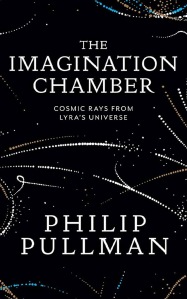 The Imagination Chamber: Cosmic Rays from Lyra’s Universe by Philip Pullman. David Fickling Books/Scholastic, 2022. Pullman has issued several little volumes set in the His Dark Materials universe; if they were edible, each would be hardly a mouthful. This is printed on rectos only, some pages with only a few sentences, so a very quick read. I hear that Sir Philip is nearly finished writing the third and last volume of his second trilogy, The Book of Dust; when that finally appears, I’ll have to go back and read the first two in succession before reading the third, because (as with Aaronovitch’s series above) there has been so much time between the instalments. This also happened with the first trilogy: I had to re-read The Golden Compass (Northern Lights) when The Subtle Knife finally appeared, and both of those before reading The Amber Spyglass some time later.
The Imagination Chamber: Cosmic Rays from Lyra’s Universe by Philip Pullman. David Fickling Books/Scholastic, 2022. Pullman has issued several little volumes set in the His Dark Materials universe; if they were edible, each would be hardly a mouthful. This is printed on rectos only, some pages with only a few sentences, so a very quick read. I hear that Sir Philip is nearly finished writing the third and last volume of his second trilogy, The Book of Dust; when that finally appears, I’ll have to go back and read the first two in succession before reading the third, because (as with Aaronovitch’s series above) there has been so much time between the instalments. This also happened with the first trilogy: I had to re-read The Golden Compass (Northern Lights) when The Subtle Knife finally appeared, and both of those before reading The Amber Spyglass some time later.
Decimus Burton: Gentleman Architect by Paul A. Rabbitts. Lund Humphries, 2021. Burton (1800–1881) was a leading architect of his day, and I’ve seen some of his buildings in person, e.g. the Athenaeum Club in London and the Temperate House at Kew Gardens. This book unfortunately doesn’t do him enough justice. The author quotes too much relative to his own writing (which admittedly is rather dull), the format of the volume is too small for the illustrations, and it needs maps and more plans.
The Real J.R.R. Tolkien: The Man Who Created Middle-earth by Jesse Xander. White Owl, 2021. This is mainly a reworking of Humphrey Carpenter’s biography and Colin Duriez’s Tolkien: The Making of a Legend. And oh my, it gets so much wrong: ‘Middle-Earth’ spelled thus, The Lord of the Rings described as a trilogy (it’s not), Vincent Trough rather than Trought, Simon Tolkien as Priscilla’s son rather than her nephew (Christopher’s eldest son), Stanley Unwin asking Tolkien to illustrate The Hobbit when Tolkien in fact put his pictures forward off his own bat, etc., etc., nothing a simple fact check wouldn’t have caught. The dust-jacket is nice, though.
Fuseli: Drama and Theatre. Edited by Eva Reifert, et al. Prestel, 2018. A somewhat repetitive account of the Swiss painter, a contemporary of Blake, who lived much of his life in Britain and produced intriguing, sometimes grotesque art based on Homer, Shakespeare, Milton, Norse mythology, etc. But the volume is in a dramatic tall (but not oversized) format, with bold typography and excellent reproductions.
The Great Troll War by Jasper Fforde. Hodder & Stoughton, 2021. The fourth and final book in Fforde’s Last Dragonslayer series. It has some clever moments, such as when an unnamed fantasy author is brought in to divine the villain’s plot, and it’s clearly Fforde himself. But the series was sufficient with just the first three titles, and even then is among the weakest of Fforde’s several series: prefer the Thursday Next titles.
John Edgar Platt: Master of the Colour Woodcut by Hilary Chapman. St Barbe Museum & Art Gallery / Samsom & Company, 2018. Sansom (1886–1967) was a painterly artist influenced by Japanese colour woodcuts. This is a short book and catalogue about his work, another title found at Pallant House.
In Praise of Aldus Manutius: A Quincentenary Exhibition by H. George Fletcher. Pierpont Morgan Library and University Research Library, Department of Special Collections, University of California, Los Angeles, 1995. I worked with books printed by Aldus and his successors for many years; we had a copy of this catalogue, and belatedly I decided to add one to my professional library. Aldus (Aldo Manuzio) was the quintessential printer of the Italian Renaissance, from which came some of the most beautiful printing types as well as the pocket-sized book.
Hail and Farewell
Wayne writes: The ‘hail’ of our title is our way of saying ‘hello’ again to our readers, after more than two years of silence on this site, and especially to those who have recently subscribed to our blog despite more than two years of silence. The ‘farewell’, in turn, is my bidding good-bye to the job I held as a college rare books librarian for more than forty-five years, which I mentioned was in the cards in our post of 26 December 2021.
I retired in February 2022, more than a year earlier than I had intended. I had planned to stay until summer 2023, to mark my 70th birthday and ‘my’ library’s centenary, which seemed appropriate and long enough (my predecessor held on until age 77). I had not grown tired of the library’s superb collections, and since 2015 I was at last the director, after thirty-nine years as junior. I knew the best antiquarian dealers, and enjoyed collecting many excellent books, manuscripts, and other materials. I found it rewarding to help generations of students with their courses, and I hope I inspired them to learn from the rarities I put into their hands.
During the pandemic shutdown, however, when I worked from home or in a nearly deserted library, I had time to reflect, and not only on how precious time with a loved one can be, and how suddenly it might be taken away. The college had become, I felt, uncomfortably bureaucratic (if, maybe, no more so than has happened at other schools), with meetings, reports, and strategic plans overwhelming actual education and scholarship. In particular, two administrative restructurings I thought very ill-advised had reduced my library from the discrete, visibly special entity intended by its founder to merely part of a department within the general library; and in the process, my authority as director was hobbled if not eliminated. I felt out of sympathy with (much younger) management and colleagues as to what a special library should acquire, how it should be organized, how its budget should be spent, and they in turn seemed to be out of sympathy with me. Also, I realized that most of the faculty and staff I had enjoyed working with over the years had themselves either retired or passed away. All things considered, I decided it would be best that I leave too, just before I turned 69 rather than wait until 70.
Another reason I felt I should retire earlier than planned – and why our blog has been quiet for so long – is that Christina and I have been working on a new book. I had not been able to give it many hours while holding down a nine-to-five job, and as we were facing a deadline (in the event, extended) it was clear that something would have to give. Look for more news about this next week.
Book Notes, June–December 2021
Wayne writes: In no particular order, here are books I read during the past few months. It’s an embarrassingly small number, which I put down to: our having subscribed to the New Yorker, which has distracted from books (but is such a civilized magazine); my having taken up crossword puzzles; and my being occupied with things to do as I approach retirement from my library job after more than forty-five years.
The Cause: The American Revolution and Its Discontents, 1773–1783 by Joseph J. Ellis. Liveright, 2021. I’ve enjoyed Ellis’s books on the Revolutionary period (e.g. The Quartet, the Pulitzer Prize-winning Founding Brothers). He has an easy style, and I’ve always learned something new from him, which I’ve been able to use in lecturing at Williams College about American documents. That said, The Cause is a short book for a big subject, and feels miscellaneous in its coverage, skipping over some events I would have liked to see treated more fully. Well, I’m sure it’s the book Ellis wanted it to write, and we should judge it as such. But it could have used better copy-editing: it has a few typos and one real bloomer, where Ellis credits the phrase ‘the shot heard round the world’ to Longfellow rather than Emerson, and it frequently has ‘comprise’ when ‘compose’ would be correct.
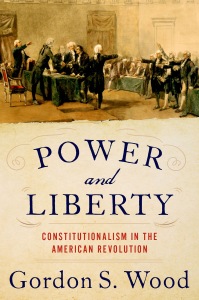 Power and Liberty: Constitutionalism in the American Revolution by Gordon S. Wood. Like Joseph Ellis, Gordon Wood is one of the leading scholars of the early American republic. His manner of writing is more staid, and his style can be repetitive, but this book too opened my eyes to a great deal of history I had never learned, such as that some who supported the proposed federal constitution did so because Rhode Island (especially) had harmed upper-class financial interests by flooding the country with paper money not backed by specie. Whenever I read books like Power and Liberty I think back to high school, where everything was compressed, leaving no time for interesting stories or sidelights, and to college, where the first course in American history was hijacked by the professor’s personal interests: ‘You heard all about the Pilgrims in high school, we’re going to spend the semester talking about slavery!’ Then the instructor in American History 102 assumed that we had, in fact, heard about the Pilgrims, and everything else up to the Civil War, in 101; but we hadn’t, so were at a disadvantage.
Power and Liberty: Constitutionalism in the American Revolution by Gordon S. Wood. Like Joseph Ellis, Gordon Wood is one of the leading scholars of the early American republic. His manner of writing is more staid, and his style can be repetitive, but this book too opened my eyes to a great deal of history I had never learned, such as that some who supported the proposed federal constitution did so because Rhode Island (especially) had harmed upper-class financial interests by flooding the country with paper money not backed by specie. Whenever I read books like Power and Liberty I think back to high school, where everything was compressed, leaving no time for interesting stories or sidelights, and to college, where the first course in American history was hijacked by the professor’s personal interests: ‘You heard all about the Pilgrims in high school, we’re going to spend the semester talking about slavery!’ Then the instructor in American History 102 assumed that we had, in fact, heard about the Pilgrims, and everything else up to the Civil War, in 101; but we hadn’t, so were at a disadvantage.
Kay Nielsen: An Enchanted Vision: The Kendra and Allan Daniel Collection by Meghan Melvin, with an essay by Alison Luxner. Museum of Fine Arts, Boston, 2021. We saw a lovely exhibition of Danish artist Nielsen’s (1886–1957) works from the Daniels’ collection at the MFA two years ago. This book, less a catalogue of the exhibition than a related monograph, has finally appeared. It’s an attractive volume, well illustrated and with an intelligent text. Nielsen’s art is endlessly fascinating, akin to work by Aubrey Beardsley and Jessie M. King and clearly influenced by Japanese prints, but uniquely his own, very unlike illustrations by contemporaries and rivals such as Rackham and Dulac. Unlike so many other art books Christina and I are reading these days, the designer of Kay Nielsen has paid attention to type size versus length of line, so that the text blocks aren’t a challenge for the eyes.
John Hassall: The Life and Art of the Poster King by Lucinda Gosling. Unicorn, 2021. Hassall (1868–1948) is best known today for his 1908 travel poster Skegness Is SO Bracing and its successors, showing a jolly fisherman prancing on a Lincolnshire beach, but this was only the smallest part of an enormous output. Hassall worked hard, and he worked fast. Gosling says perhaps more than she needs to about the artist, his life, and his methods – one can’t complain that she left something out – but it’s an interesting account of a commercial artist in Britain of the period, and not incidentally of the business of art at that time. One could wish, however, for a larger format: so many of the illustrations are tiny, and their captions (in narrow sans-serif) tinier still.
Questland by Carrie Vaughn. Mariner Books, 2021. A bit of fluff, really, but amusing. I’m a selective fan of Vaughn’s novels (Bannerless, for example), and Questland seemed up my street. The hero is a literature professor with expertise in fantasy, hired to help a mercenary strike team penetrate the defences of a high-tech island being developed as an amusement destination with animatronic dragons, unicorns, and other elements of myth and magic. It’s sort of Jurassic Park crossed with Ready Player One. RPG and Tolkien references abound.
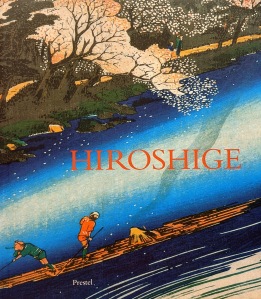 Hiroshige: Prints and Drawings by Matthi Forrer, with essays by Suzuki Jūzō and Henry D. Smith II. Prestel, 1997. An account of the work of Japanese artist Utagawa Hiroshige (1797–1858), one of the leading creators of woodblock prints. The book has many well-printed illustrations, which however represent only a fraction of Hiroshige’s pictures. In addition to their intrinsic beaity, the reproductions given here are interesting for similarities to be found between some of Hiroshige’s prints and elements in Tolkien’s art, especially for The Hobbit. We know that Tolkien was attracted to Japanese prints, and some of his illustrations have a stylistic sympathy with Hiroshige’s work, more so than, say, that of Hokusai.
Hiroshige: Prints and Drawings by Matthi Forrer, with essays by Suzuki Jūzō and Henry D. Smith II. Prestel, 1997. An account of the work of Japanese artist Utagawa Hiroshige (1797–1858), one of the leading creators of woodblock prints. The book has many well-printed illustrations, which however represent only a fraction of Hiroshige’s pictures. In addition to their intrinsic beaity, the reproductions given here are interesting for similarities to be found between some of Hiroshige’s prints and elements in Tolkien’s art, especially for The Hobbit. We know that Tolkien was attracted to Japanese prints, and some of his illustrations have a stylistic sympathy with Hiroshige’s work, more so than, say, that of Hokusai.
Guarded by Dragons: Encounters with Rare Books and Rare People by Rick Gekoski. Constable, 2021. Book dealer and literary treasure-hunter Gekoski supplies thirteen essays on writers, literary research, and the adventures and perils of the book trade. He drops a lot of names, from D.H. Lawrence to J.K. Rowling, among them two or three I know, or knew, personally from my years as a librarian. I found myself nodding frequently in agreement at his afterword: ‘I regret the gradual decline of connoisseurship, a term more often associated with the art market, but which can be pertinent to sophisticated book collecting.’ My first boss at Williams said that it was his goal in the Chapin Library to teach the students to be connoisseurs of books, and he did succeed with a few; but this wasn’t, and isn’t, the goal of the faculty, and it’s their work we’re meant to support. ‘For many of us [booksellers, bookselling] is a vocation, rather than a job, which can be practised to the very edges of senility, and sometimes beyond. You can still hunt treasure even when you don’t remember where it is. But if we carry on, it is not always a comfortable process . . . it is too easy, and in a way too agreeable, to compare the past favourably with the present.’ I’ve bought and worked with books and manuscripts, professionally, about as long as Gekoski has sold them, and although it has been a job, it has also been part of my life – what I think Gekoski is getting at – not something I leave at the office at five o’clock. And although much of the present is preferable to the past (I do not miss typing catalog cards), many good things of the past were better (more civilized, more elegant) than what pertains now.
Imperial Splendor: The Art of the Book in the Holy Roman Empire, 800–1500 by Jeffrey F. Hamburger and Joshua O’Driscoll. Morgan Library & Museum/D. Giles, 2021. Published to accompany the exhibition held at the Morgan Library & Museum, New York, on now until 23 January 2022; Christina and I saw it last month. The book is informative but hard on the eyes, with lines of type spread out both horizontally and vertically. Its colour reproduction is good, but some of its pictures are much smaller than the original book or page.
The Left-handed Twin by Thomas Perry. Mysterious Press, 2021. The ninth of Perry’s Jane Whitefield novels, featuring a Native American woman who helps people in fear of their lives disappear into a new identity. These books (since Vanishing Act, 1996) have been entertaining, sometimes gripping, but in the new story the author seems to have been concerned only to write a potboiler to attract fans of the series (clearly, it did the trick). The situations are familiar, and so is much of the dialogue. As in every book, Jane is teaching a frightened client to live a secret life, and as in Poison Flower (2012), criminals are trying to capture Jane in order to locate the people she has helped over the years. What we haven’t seen before is an ending this contrived and unsatisfying. With The Left-handed Twin (the title refers to Hanegoategeh, the Destroyer, a Native American devil figure), Perry has taken this series perhaps as far as it should go.
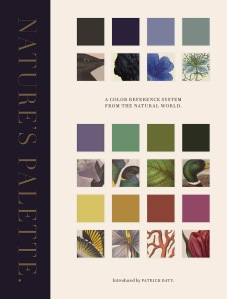 Nature’s Palette: A Color Reference System from the Natural World. Princeton University Prss, 2021. I need to preface this note with mention of The Anatomy of Colour: The Story of Heritage Paints and Pigments by Patrick Baty (Thames & Hudson, 2017; the U.S. edition, from the same publisher, is The Anatomy of Color – presumably someone felt that Americans would not buy the book with the -our spelling, but I did). I see that I bought The Anatomy of Colour in 2017, but didn’t read it until earlier this year or late last year, and seem to have overlooked it when writing previous Book Notes. Its history of paints is fascinating, and it has a strong bibliographical component, describing house-painting and colour manuals through the years, and it’s beautifully designed. Then, not too many months ago, I ran across an algorithm-generated recommendation for Nature’s Palette, which has a similar design aesthetic, and again the participation (but not sole authorship) of Patrick Baty, historic paint consultant. The later book, also a visual delight and bibliographically informative, takes as its point of departure the importance and influence of German geologist Abraham Gottlob Werner’s Nomenclature of Colours, devised in 1774 and subsequently expanded and refined by others.
Nature’s Palette: A Color Reference System from the Natural World. Princeton University Prss, 2021. I need to preface this note with mention of The Anatomy of Colour: The Story of Heritage Paints and Pigments by Patrick Baty (Thames & Hudson, 2017; the U.S. edition, from the same publisher, is The Anatomy of Color – presumably someone felt that Americans would not buy the book with the -our spelling, but I did). I see that I bought The Anatomy of Colour in 2017, but didn’t read it until earlier this year or late last year, and seem to have overlooked it when writing previous Book Notes. Its history of paints is fascinating, and it has a strong bibliographical component, describing house-painting and colour manuals through the years, and it’s beautifully designed. Then, not too many months ago, I ran across an algorithm-generated recommendation for Nature’s Palette, which has a similar design aesthetic, and again the participation (but not sole authorship) of Patrick Baty, historic paint consultant. The later book, also a visual delight and bibliographically informative, takes as its point of departure the importance and influence of German geologist Abraham Gottlob Werner’s Nomenclature of Colours, devised in 1774 and subsequently expanded and refined by others.
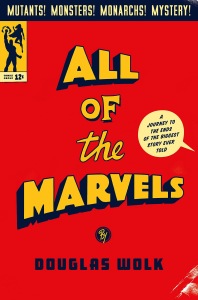 All of the Marvels by Douglas Wolk. Profile Books, 2021. Wolk, a critic of music and comics, read 27,000-plus superhero books published by Marvel Comics in order to write about them as a vast, interconnected epic, and about their creators (especially Lee, Kirby, and Ditko) and their influence on popular culture. I don’t entirely buy the interconnected-epic argument, given the many restarts and reinventions since the Marvel stories began in the 1960s, but as an old (literally) comics hand, I found it interesting to read of Wolk’s journey and to look back on my own on-and-off experiences with Marvel. I was a Batman and Superman fan from the late fifties, following their titles as well as delighting in the occasional DC surprise, such as the Doom Patrol in My Greatest Adventure and the Metal Men in Showcase. Then, aged eleven, I ran across Fantastic Four no. 20, November 1963, ‘The Mysterious Molecule Man!’ and was hit hard by Jack Kirby’s art (much more so than by Stan Lee’s script). I didn’t know who these characters were, but suddenly Superman and Batman were prosaic in comparison. I started an X-Men run with no. 7 (‘The Return of the Blob!’), and Spider-Man with no. 9 (‘The Man Called Electro!’, wowed by Steve Ditko’s drawing) * – it was an exciting time. I gave up comics in high school, as my interests turned elsewhere (especially to Tolkien), but was drawn back in the early eighties when I read that Jean Grey of X-Men had died; at that time a comic hero’s death was not yet common, except in an ‘imaginary story’, and I was intrigued. Comics dealers having become a thing, I was able to find back issues, and became hooked by the Claremont and Byrne/Austin X-Men, Byrne’s ‘back to basics’ revamp of the Fantastic Four, and so much else (such as the Levitz/Giffen Legion of Super-heroes and the Wolfman/Pérez New Teen Titans, returning also to DC’s line).
All of the Marvels by Douglas Wolk. Profile Books, 2021. Wolk, a critic of music and comics, read 27,000-plus superhero books published by Marvel Comics in order to write about them as a vast, interconnected epic, and about their creators (especially Lee, Kirby, and Ditko) and their influence on popular culture. I don’t entirely buy the interconnected-epic argument, given the many restarts and reinventions since the Marvel stories began in the 1960s, but as an old (literally) comics hand, I found it interesting to read of Wolk’s journey and to look back on my own on-and-off experiences with Marvel. I was a Batman and Superman fan from the late fifties, following their titles as well as delighting in the occasional DC surprise, such as the Doom Patrol in My Greatest Adventure and the Metal Men in Showcase. Then, aged eleven, I ran across Fantastic Four no. 20, November 1963, ‘The Mysterious Molecule Man!’ and was hit hard by Jack Kirby’s art (much more so than by Stan Lee’s script). I didn’t know who these characters were, but suddenly Superman and Batman were prosaic in comparison. I started an X-Men run with no. 7 (‘The Return of the Blob!’), and Spider-Man with no. 9 (‘The Man Called Electro!’, wowed by Steve Ditko’s drawing) * – it was an exciting time. I gave up comics in high school, as my interests turned elsewhere (especially to Tolkien), but was drawn back in the early eighties when I read that Jean Grey of X-Men had died; at that time a comic hero’s death was not yet common, except in an ‘imaginary story’, and I was intrigued. Comics dealers having become a thing, I was able to find back issues, and became hooked by the Claremont and Byrne/Austin X-Men, Byrne’s ‘back to basics’ revamp of the Fantastic Four, and so much else (such as the Levitz/Giffen Legion of Super-heroes and the Wolfman/Pérez New Teen Titans, returning also to DC’s line).
Two days ago, the New York Times ran an article by Julie Lasky, ‘How Many Books Does It Take to Make a Place Feel Like Home?’ Lasky quotes Reid Byers, author of the recent book The Private Library: The History of the Architecture and Furnishing of the Domestic Bookroom (Oak Knoll Press), who has coined the term book-wrapt ‘to describe the exhilarating comfort of a well-stocked library’. Byers suggests 500 volumes as a minimum number for ‘any self-respecting home library’, though he allows that a smaller quantity is possible, in a smaller space. One of the accompanying photos shows a ‘book wall’ which is more whatnots than books, so really a cheat to think of it as a ‘library’. There are more than a thousand comments attached to the article as of this writing, predictably a blend of ‘never enough books’ and ‘get a Kindle’. (Yes. No.)
Tolkien Notes 20
This will be a shorter ‘Notes’ than usual, indeed very brief, as we’re pressed for time, with various appointments, landscape work on our property to do or be scheduled (we’ll have another post about our garden soon), car repairs, and so forth. But nothing Covid-related: we’re fully vaccinated, and life where we are, at least, has returned to mostly-maskless. Of course it’s less good in many other places, which is worrying. And there are still many restrictions on travelling.
In Tolkien news, addenda and corrigenda for our books (mainly addenda) are accumulating, and we’ll have another group of these posted to our website before long. We’re catching up with several books about Tolkien from the past few years, including Holly Ordway’s work on Tolkien’s reading, which have provided new information or different perspectives. There are also a number of Tolkien-related textual questions we’ve received, which we assure the writers we’ll answer, or try to.
Speaking of catching up, a long Zoom interview we gave on 25 February to four Portuguese-speaking Tolkien enthusiasts – but speaking in English to us – has just been posted to YouTube. For this, our thanks to Cesar, Inês, Ronald, and Sérgio. (It was a pleasant surprise to learn that Christina already knew Ronald Kyrmse, from correspondence back in the 1980s in regard to the linguistic journal Quettar.) The interview is one of many videos (most of them in Portuguese) on the YouTube channel ‘Tolkien Talk’, including some devoted to our books.
Book Notes, April–May 2021
Wayne writes: Not in any particular order, here are books I read during April and May (and an extra):
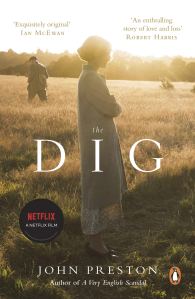 The Dig by John Preston. Penguin Books, 2021 (first published 2007). A fictionalized account of the discovery and excavation of the Sutton Hoo ship-burial treasure. ‘Certain changes have been made for dramatic effect’: indeed, yes. Preston is entertaining, but fortunately we have some good books on the actual events, which involved many more people and multiple dig seasons.
The Dig by John Preston. Penguin Books, 2021 (first published 2007). A fictionalized account of the discovery and excavation of the Sutton Hoo ship-burial treasure. ‘Certain changes have been made for dramatic effect’: indeed, yes. Preston is entertaining, but fortunately we have some good books on the actual events, which involved many more people and multiple dig seasons.
Fearless by Allen Stroud. Flame Tree Press, 2020. This seemed from descriptions as if it might be a good science-fiction novel about a sort of Coast Guard-rescue ship in space. Not quite. It’s ‘woke’ in a forced way, it’s told awkwardly from multiple points of view and in ‘real time’ (a character telling the story in one chapter turns up dead in the next), the physics of the action are questionable, and the novel ends without a resolution – so, the start of a series, but I won’t be returning.
E. McKnight Kauffer: The Artist in Advertising, edited by Caitlin Condell and Emily M. Orr. Rizzoli/Electa and Cooper Hewitt, 2020. Kauffer was an American graphic artist (1890–1954), a pioneer of the Modernist poster and dust-jacket. This new biography, by multiple authors, is a good example of how to make a book uncomfortable for the reader. The main type is sans serif, none too large and with enormous indents, shoulder notes are in a tiny (six point?) typewriter-style face and in red, and captions are also tiny, in a light roman font, and difficult to relate to the pictures. The text shifts here and there on the page, out of alignment, as do the illustrations, which are not always as sharp as they might be. The book’s designer, who explains at length in a sort of manifesto, chose to reflect Kauffer’s personal contradictions and ‘varied nature’; each spread is ‘its own composition and . . . part of the overall gestalt’. Sorry, no, not over nearly 300 pages. Prefer Mark Haworth-Booth’s E. McKnight Kauffer: A Designer and His Public (2nd ed. 2005).
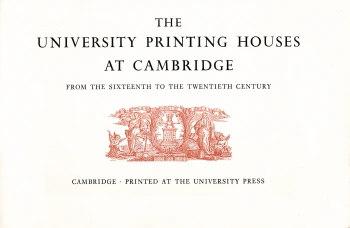 The University Printing Houses at Cambridge from the Sixteenth to the Twentieth Century by Brooke Crutchley. Cambridge University Press, 1962. This is one of the series of short Christmas books issued by the University Printer in Cambridge for many years. I had long admired the Chapin Library’s copy – elegantly printed in an oblong format, bound in a lovely rust-colored cloth, and housed in a marbled-paper slipcase – and when a chance came along recently to buy one for myself at a discounted price, I leaped at it. Now if I could find, also at a good price, the 1961 Cambridge Christmas book, Bridges on the Backs, with lift-the-flap illustrations by David Gentleman, I would be even happier.
The University Printing Houses at Cambridge from the Sixteenth to the Twentieth Century by Brooke Crutchley. Cambridge University Press, 1962. This is one of the series of short Christmas books issued by the University Printer in Cambridge for many years. I had long admired the Chapin Library’s copy – elegantly printed in an oblong format, bound in a lovely rust-colored cloth, and housed in a marbled-paper slipcase – and when a chance came along recently to buy one for myself at a discounted price, I leaped at it. Now if I could find, also at a good price, the 1961 Cambridge Christmas book, Bridges on the Backs, with lift-the-flap illustrations by David Gentleman, I would be even happier.
Arts and Crafts Pioneers: The Hobby Horse Men and Their Century Guild by Stuart Evans and Jean Liddiard. Lund Humphries, 2021. A good, if overly long, account of a different side of British art and design, and (especially from my point of interest) book production, in the late nineteenth century, concurrent with and following on the work of William Morris. Well illustrated in a tall format.
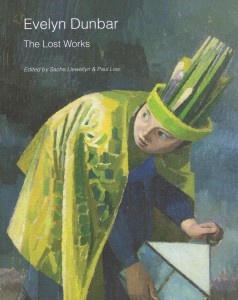 Evelyn Dunbar (1906–1960): The Lost Works, edited by Sacha Llewellyn and Paul Liss. Liss Llewellyn Fine Art and Pallant House Gallery, 2015. Dunbar is best known for her Second World War paintings of Land Girls and other scenes from the home front, but like so many other British artists of the period, she had a varied output including murals and book illustration. The ‘lost works’ of the title refers to a cache of Dunbar art set aside at her early death and forgotten, though in family hands, for a generation. Dunbar’s biography is more fully presented in Gill Clarke’s excellent Evelyn Dunbar: War and Country (2006), and more recently in Evelyn Dunbar: A Life in Painting (2016) by the artist’s nephew, Christopher Campbell-Howes, which I have yet to read.
Evelyn Dunbar (1906–1960): The Lost Works, edited by Sacha Llewellyn and Paul Liss. Liss Llewellyn Fine Art and Pallant House Gallery, 2015. Dunbar is best known for her Second World War paintings of Land Girls and other scenes from the home front, but like so many other British artists of the period, she had a varied output including murals and book illustration. The ‘lost works’ of the title refers to a cache of Dunbar art set aside at her early death and forgotten, though in family hands, for a generation. Dunbar’s biography is more fully presented in Gill Clarke’s excellent Evelyn Dunbar: War and Country (2006), and more recently in Evelyn Dunbar: A Life in Painting (2016) by the artist’s nephew, Christopher Campbell-Howes, which I have yet to read.
Time for Tea by Tom Parker Bowles. 4th Estate, 2021. The latest publication from Fortnum & Mason, London grocers and tea merchants (since 1707). Much more than everything you ever wanted to know about tea, and a blessing to anyone wanting to be a tea connoisseur: where tea is grown, how it’s grown, what kind of tea (so many kinds) one should choose to fit a mood or occasion, much more sophisticated than my Darjeeling if I can get it, but English Breakfast in a pinch (and for breakfast, with lots of milk and one sugar), and Orange Pekoe for iced tea. Plus recipes for scones, etc. I have a fondness for Fortnum’s, and very much regret that they gave up (due to the pandemic) their gallery restaurant in the Piccadilly store as well as their satellite café at St Pancras.
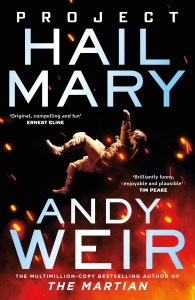 Project Hail Mary by Andy Weir. Del Rey, 2021. I enjoyed The Martian, but skipped Weir’s Artemis as it had terrible reviews and features a wisecracking petty criminal, which I didn’t think would appeal to me. One review of Project Hail Mary noted that Weir now returns to his hero ‘sciencing’ his way out of many, many problems, which was enough to convince me to order an autographed copy from Blackwell’s (and I liked the U.K. dust-jacket better than the American one, and Blackwell’s pack so beautifully). Science, indeed, to the extent that having some math and physics and biology background is definitely a plus for reading this book. Anyway: hey, I read a best-seller! It’s not often that my tastes align with the mainstream. Although I did read another best-seller recently, which I forgot to put into my January notes:
Project Hail Mary by Andy Weir. Del Rey, 2021. I enjoyed The Martian, but skipped Weir’s Artemis as it had terrible reviews and features a wisecracking petty criminal, which I didn’t think would appeal to me. One review of Project Hail Mary noted that Weir now returns to his hero ‘sciencing’ his way out of many, many problems, which was enough to convince me to order an autographed copy from Blackwell’s (and I liked the U.K. dust-jacket better than the American one, and Blackwell’s pack so beautifully). Science, indeed, to the extent that having some math and physics and biology background is definitely a plus for reading this book. Anyway: hey, I read a best-seller! It’s not often that my tastes align with the mainstream. Although I did read another best-seller recently, which I forgot to put into my January notes:
Ready Player Two by Ernest Cline. Ballantine Books, 2020. I read Ready Player One not all that many years ago, enjoyed it, and like other readers never thought that it needed a sequel. After reading Ready Player Two, my opinion hasn’t changed. Characters who were sympathetic in the first book are here acting like jerks, and if they have only a limited time to save the world (another quest!), why do they sometimes act as if they aren’t on the clock? To be fair, I also enjoyed Ready Player One more than the sequel probably because I was more familiar with the pop culture Cline used in the first book, compared with what Wade and his friends deal with in Ready Player Two, except for one chapter set in the world of The Silmarillion. I’m hopeless with the music of Prince, and with most of the films of John Hughes.
Tolkien’s Modern Reading
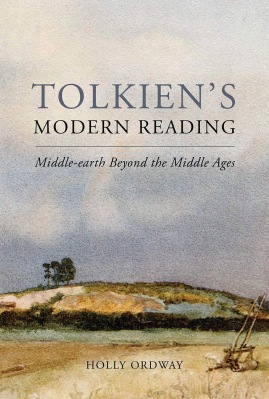 Tolkien’s Modern Reading: Middle-earth beyond the Middle Ages (Word on Fire Academic, 2021) is advertised as a ‘major corrective’ to the idea that ‘Tolkien was dismissive of modern culture, and that The Hobbit and The Lord of the Rings are fundamentally medieval and nostalgic in their inspiration’ (to quote the jacket blurb). We were eager to read it, not least to see what Holly Ordway would make of an argument – that Tolkien distanced himself from modern (contemporary) literature – which was put to rest some time ago. See, for example, our article ‘Reading’ in The J.R.R. Tolkien Companion and Guide (2006, second edition 2017) or even, much earlier, L. Sprague de Camp’s passing remark in Literary Swordsmen and Sorcerers (1976) that ‘practically anything in English literature, from Beowulf down, Tolkien had read and could talk intelligently about’ (p. 244).
Tolkien’s Modern Reading: Middle-earth beyond the Middle Ages (Word on Fire Academic, 2021) is advertised as a ‘major corrective’ to the idea that ‘Tolkien was dismissive of modern culture, and that The Hobbit and The Lord of the Rings are fundamentally medieval and nostalgic in their inspiration’ (to quote the jacket blurb). We were eager to read it, not least to see what Holly Ordway would make of an argument – that Tolkien distanced himself from modern (contemporary) literature – which was put to rest some time ago. See, for example, our article ‘Reading’ in The J.R.R. Tolkien Companion and Guide (2006, second edition 2017) or even, much earlier, L. Sprague de Camp’s passing remark in Literary Swordsmen and Sorcerers (1976) that ‘practically anything in English literature, from Beowulf down, Tolkien had read and could talk intelligently about’ (p. 244).
We were also curious to learn if Ordway had identified more works that Tolkien read which we had not yet taken into account. Indeed she has, and in doing so takes admirable care in her method of proof. ‘For instance,’ she notes, ‘although Tolkien refers on several occasions to Jekyll and Hyde, I do not believe we can take this as definitively establishing that he had read Stevenson’s novel (though it is probable that he did so), because the Jekyll–Hyde dichotomy has become a commonplace. Here the critic must make a judgment call on each individual allusion’ (pp. 30–1). Is it likely that Tolkien read John Buchan’s Midwinter, The Blanket of the Dark, and Huntingtower, in which scholars have found parallels with The Lord of the Rings and The Hobbit? Yes, says Ordway, it is ‘highly likely’, but ‘it is not certain that Tolkien read them, and therefore we must handle them differently than true “certains”’ (p. 31). She lists her ‘certains’ in a useful tabular appendix, comprising ‘148 authors and more than 200 titles’ (p. 295).
Ordway defines ‘modern reading’ as works of fiction, poetry, and drama in the English language published no earlier than 1850. One could quibble with this distinction, and Ordway does so herself: modernity, she admits, ‘did not begin either in 1850 or in any other particular year, but some sort of cut-off point is necessary’ (p. 27). 1850 is a convenient date to delimit works Tolkien would have considered modern, though it is also inconvenient as it eliminates from discussion authors we know he read, such as Scott, Macaulay, and Swift. Moreover, the term modern has more than one definition, both chronological and conceptual.*
Not without reason, Ordway blames Humphrey Carpenter for the impression that Tolkien was not interested in modern (i.e. post-1849) literature. In The Inklings (1978) Carpenter wrote that Tolkien’s ‘roots were buried deep in early literature, and the major names in twentieth-century writing meant little or nothing to him’ (p. 158). Carpenter’s 1977 biography of Tolkien suggests this also. For those of us who read Carpenter’s books at or soon after publication, there was little else in print at that time which might call Carpenter into question, and the views of Tolkien’s authorized biographer carried special weight. More than forty years later, much has been added to our knowledge of Tolkien’s life and interests, as more resources have come to light or been opened for use, and one can now see how Carpenter’s statements may be flawed. Ordway claims that ‘Carpenter’s account of Tolkien’s creative life’ has tended ‘to squelch further study of Tolkien’s modern reading’ (p. 7), but this may be true only for those who read Carpenter’s work uncritically, or consult little or nothing else in the now very extensive literature of Tolkien studies.
Though Carpenter’s Biography and The Inklings aren’t correct in every respect, they have much of value, and don’t deserve the heavy weight of criticism Ordway persistently lays upon them. She also takes Carpenter unfairly to task for his edition of Tolkien’s letters (1981), which she says ‘reflects something of Carpenter’s unsympathetic attitude toward his subject. Both in his selection of letters and in his editing of them we can observe an agenda at work that serves to make Tolkien seem impatient, defensive, and uninterested in anything modern’ (p. 12). There was indeed an ‘agenda’ in the editing of The Letters of J.R.R. Tolkien, but it is to be explained by marketing decisions rather than personal bias. Carpenter, with Christopher Tolkien as collaborator, was faced with an immense number of surviving letters, many of which had to be left out of what was intended only as a selection, in order to have a book of reasonable size which could be sold at a reasonable price.† Also, to create a book with potentially the most interest to Tolkien fans, there was a deliberate focus on letters in which Tolkien discussed his Middle-earth stories, with the result that other subjects were given less attention than many of us would like, such as Tolkien’s family life, his academic career, and his dealings with publishers. One can regret this approach while understanding its practicality.
It was for these reasons that some letters were truncated, some of them severely – chiefly to extract information relevant to The Hobbit, The Lord of the Rings, and ‘The Silmarillion’. One need not find anything sinister about it. It’s unfortunate, for example, that Tolkien’s letter of 31 December 1960 to Professor L.W. Forster (Letters, p. 303) ends just at an intriguing reference to William Morris, making it ‘impossible to say whether Tolkien provided more explanation or context for his remark’ (Ordway, p. 323, n. 54). We do not ourselves have access to the original letter, so can’t answer the question; and yet, it seems likely that if Tolkien had had more to say about an influence on The Lord of the Rings, Carpenter would have printed it. We can, at least, defend Carpenter in another instance: on p. 51 of her book, Ordway refers to Tolkien’s letter to Charles Furth of 31 August 1937, in which he writes that Carroll’s Through the Looking-glass is ‘much closer [to The Hobbit than Alice’s Adventures in Wonderland] in every way’. ‘Unfortunately,’ Ordway says in a footnote, ‘Carpenter has chosen to omit the rest of the sentence . . . so we lack any explanation Tolkien might have provided for the comparison.’ Here we do have access to the letter, from the Allen & Unwin archive, and can confirm that Tolkien stopped writing at that point, and Carpenter omitted nothing.
In another note, Ordway complains that the index to Letters omits any citation to the Virgin Mary, ‘despite a number of references to her by Tolkien’ in the text, an omission which ‘reflects Carpenter’s lack of interest’ (p. 12). In fact, we have long thought that the original index to Letters (before it was replaced by our expanded index in 2000) may not have been Carpenter’s own work. Its contents and construction suggest that it was made by someone with much less familiarity with the letters, and with Tolkien, than Carpenter himself certainly had. So one should not accuse him of a lack of interest in Roman Catholicism, or in Christianity, because of an omitted reference; it may have been out of his hands (though one could perhaps argue that an editor should bear final responsibility for his book’s apparatus). Ordway also criticizes Carpenter’s criteria in the selection of letters to publish, referring to him as ‘an atheist who had rejected an Anglican upbringing . . . and who described Tolkien’s Christian values as “uptight”’ (p. 262n). In fact there are many references to Tolkien’s faith in Letters: we needed a third of a column in our revised index to cite them.
Ordway’s account of Tolkien’s interest in post-1849 literature, while not entirely original, usefully adds to our knowledge. Her argument that Tolkien read more modern works than is generally known is valid, and she makes it with impressive industry. She does not do so entirely for its own sake, however, but to support the main thrust of her book, which is the identification of literary sources and influences in Tolkien’s Middle-earth fiction other than the medieval works on which critics have tended to focus. She spends not a little space defending source-hunting (or influence-hunting) in regard to Tolkien, presumably to fend off critics like ourselves, who object that Tolkien’s works can be made to seem ‘less original creation than a patchwork of second-hand ideas, [in which] every element in his books must have a pre-existing source, leaving no room for independent invention, even by an author whose powers of invention were profound’ (Reader’s Guide, 2017, pp. 1247–8).
‘As we consider the modern works that Tolkien read,’ Ordway writes,
we will see that some of them can properly be described as ‘sources’ for his own writings. We find Tolkien using this term himself when he calls E.A. Wyke-Smith’s The Marvellous Land of Snergs ‘an unconscious source-book’ – an interesting turn of phrase, as it shows that he was aware that his imagination absorbed and used what he read on a level that was recognizable later, but not necessarily conscious at the time. [pp. 33–4]
Tolkien ‘recognized that he did not write in isolation and knew that he could not have done so even if he had wanted to’ (p. 41). Conventional wisdom, Ordway says, following Diana Glyer’s research in The Company They Keep and again criticizing Carpenter, has it that Tolkien was immune to influence, when in fact he was subject to it and made use of a variety of sources.
In her chapter on William Morris, for example, after recounting the aspects of Tolkien’s more elaborate prose style inspired by Morris (as Tolkien attested), Ordway discusses his comment in his letter to Professor Forster that ‘the Dead Marshes and the approaches to the Morannon [in The Lord of the Rings] owe something to Northern France after the Battle of the Somme [but] they owe more to William Morris and his Huns and Romans, as in The House of the Wolfings or The Roots of the Mountains’ (Letters, p. 303). Ordway draws from this stray remark an argument culminating in the suggestion that ‘Tolkien’s Orcs were, in his creative imagination, mediated through Morris’s Huns and Romans’ (p. 178), who are presented as evil, corrupt, foul enemies in the two works in question. She looks for parallels and tries to divine Tolkien’s thinking, referring to ‘possible literary influences’ (p. 182). But in her summary of this chapter she states more strongly: ‘We have carefully followed the traces and discovered that these works contributed not only to Tolkien’s construction of the landscape through which Frodo and Sam journey en route to Mordor, but probably helped to shape Tolkien’s creation of the Orcs as he imagined Morris’s Huns and Romans into his own sub-created world’ (p. 183). Although Ordway’s theory is intriguing, it seems to be directed only at The Lord of the Rings, whereas Orcs developed earlier, in ‘Silmarillion’ texts. One could also argue that Tolkien already had sufficiently strong, more direct, and attested sources for his Orcs in the Old English tradition and in historical barbarians from the East (as seen from the European point of view).
We found more plausible ideas in the following chapter, on H. Rider Haggard, where Ordway suggests interesting parallels between the ‘facsimile’ map in Haggard’s King Solomon’s Mines and Thror’s Map in The Hobbit, and between the ‘Sherd of Amenartas’ in Haggard’s She, densely covered with inscriptions, and the Dwarves’ Book of Mazarbul in Moria. We were also particularly struck by her comment that ‘images and scenes need not have a single source’ (p. 190, referring to her comparison of the caverns of Helm’s Deep to a treasure chamber in King Solomon’s Mines, while Tolkien himself noted Cheddar Caves in Somerset as his caverns’ inspiration) and her admission that some parallels between Ayesha and Galadriel ‘may be fortuitous correspondences’. Observations like these, allowing for alternate sources and for chance, should constantly inform any attempt at source-hunting.
On the other hand, Ordway remarks that the ‘Head of the Ethiopian’, a mountain top in She ‘carved into a massive head, which the travelers see as their ship approached its African destination’, ‘is suggestive of the Pillars of the Kings’ in The Lord of the Rings (p. 193). But these seem to us distinctly different, and the Pillars have real-world counterparts closer in conception than Haggard’s ‘Ethiopian’, such as the Colossi of Memnon in ancient Egypt. Ordway also suggests that the Sherd of Amenartas made such a strong imprint on Tolkien’s imagination that ‘it seems possible that it contributed something to the eventual formation of the One Ring’ (p. 199): well, many things are possible, but not necessarily so.
In the course of her book, besides her chapters on Morris and Haggard, Ordway explores children’s literature in Tolkien’s youth (fairy-tale collections such as Knatchbull-Hugessen’s Stories for My Children, Lewis Carroll, Andrew Lang) and later (Beatrix Potter, Arthur Ransome, Kenneth Grahame, et al.); George MacDonald; ‘boys’ adventures’ such as Crockett’s The Black Douglas, the works of John Buchan, and Barrie’s Peter Pan; science fiction, in which Ordway classifies E.R. Eddison’s ‘Zimiamvia’ stories; ‘fine fabling’, a category which includes Dunsany and Thompson, Algernon Blackwood and J.H. Shorthouse; and a very miscellaneous group with Sinclair Lewis (Babbit), Henry Wadsworth Longfellow (Hiawatha), T.S. Eliot, and G.K. Chesterton, among others.
She pays particular, and particularly lengthy, attention to Shorthouse’s John Inglesant (1881). Ordway declares that Tolkien took ‘an abiding interest’ in this curious romance. She even imagines him in 1904 standing with his mother in Duchess Road, Birmingham, as she points out ‘the house where John Inglesant was written’ (p. 1), though it seems more likely that when Mabel Tolkien left hospital in late June 1904, after treatment for diabetes, she went directly to Rednal to recuperate. Ordway cites Tolkien’s remark to Christopher Bretherton that John Inglesant was ‘queer, exciting, and debatable’ (Letters, 16 July 1964, p. 348), and she draws upon two 1975 articles by Canon Norman Power, in the Tolkien Society journal Mallorn and the Roman Catholic publication The Tablet.‡ In each of these, Power relates Tolkien’s mention, in a letter to Power, of a house in Duchess Road ‘of supreme importance in my personal history’ to his gift to Power, with the same letter, of a spare copy of the annual Essays by Divers Hands with an essay on Shorthouse and John Inglesant. (Shorthouse had been a Churchwarden at Ladywood, Birmingham, where much later Power was Vicar.) The implication of the gift, Power reckoned, is that the Duchess Road house was in sight of the Inglesant house, and John Inglesant – with its battle between Good and Evil, its strange creatures, and its scenes of pity and forgiveness – was an unknown early influence on The Lord of the Rings, one ‘unnoticed by the critics, but of which the great man was himself aware’ (quoted in Ordway, p. 239).
Ordway admits that Power ‘does little to substantiate this claim, but I agree with his basic thrust, for it seems improbable that Tolkien would have been so interested in a man whose writings were of no particular account with him’ (p. 239). She believes that John Inglesant, which in its time was admired and provoked discussion, attracted Tolkien who was interested not only in matters of Catholicism, but also ‘in books that imaginatively presented, or appeared to present, an Anglican point of view and provoked theological debate’ (p. 241). She declares, on the strength of Tolkien’s letter to Christopher Bretherton and his late correspondence with Norman Power, that John Inglesant ‘stayed in Tolkien’s memory throughout his life’ and influenced him at various points, especially in its theme of Pity which is echoed repeatedly in The Lord of the Rings.
Ordway’s argument is forceful, but her proof is tenuous. Pity, of course, is by no means unique to Shorthouse’s story, if one wanted to search for an external influence, and was an element of Tolkien’s personal faith. When he wrote about John Inglesant to Christopher Bretherton in 1964, only ten years after The Lord of the Rings began to be published in three volumes and to the puzzlement of some reviewers, it was by no means complimentary. Shorthouse was ‘a mere amateur (like myself)’ when he ‘suddenly produced a long book’ which ‘few now find it possible to read. . . . I think he never wrote any more, but wasted the rest of his time trying to explain what he had and what he had not meant in John Inglesant. . . . I have always tried to take him as a melancholy warning . . .’ (Letters, p. 348). He certainly does not look back on the experience of reading Shorthouse’s book with anything like nostalgia or gratitude.
More telling is a third, post-Biography account by Norman Power not cited in Ordway’s bibliography. Published in 1993 in Mythlore, it shows that Power now knew that the importance to Tolkien of the house in Duchess Road was not due to any relationship it had with John Inglesant, but because it was there (in the Faulkner home, at 37 Duchess Road) he met Edith, his future wife. Power still had the impression, from the book Tolkien sent him, that John Inglesant could have been a literary influence, but he does nothing more than comment on parallels of renunciation in The Hobbit (Bilbo giving up the Arkenstone) and The Lord of the Rings (Frodo renouncing the Ring, though in the end he cannot). It may be that Tolkien sent Power Essays by Divers Hands only because of the connection of Power’s church with Shorthouse, and because Tolkien happened to have an extra copy at hand, presumably from his membership in the Royal Society of Literature (publisher of the Essays).
As we read Ordway’s book, each of us in turn, we took many pages of notes. Word on Fire, the publisher of Tolkien’s Modern Reading, kindly sent us a copy for review, and we felt obliged to be thorough. Here are a few of our shorter comments:
— It is probably an overstatement to say that ‘Tolkien maintained a watching brief over developments in children’s literature well beyond the youth of his four children’ (p. 62, italics ours) simply because the first of Mary Norton’s ‘Borrowers’ books (1952–61) were in the Tolkien household.
— The 1962 volume The Adventures of Tom Bombadil and Other Verses from the Red Book, as published with more than one poem at Rayner Unwin’s suggestion, is by no means ‘physically similar to the [Beatrix] Potter books’ (p. 65), but in a much larger format. Ordway was presumably thinking of Tolkien’s original conception for publishing his ‘Bombadil’ poem by itself.
— Ordway suggests (p. 220) that Tolkien’s ‘concept of the Ban of the Valar and the fall of Númenor was shaped in part by his admiration for Perelandra’ by C.S. Lewis, which reimagines the Fall of Man. But the ban against the Númenóreans sailing west is present in the earliest version of The Fall of Númenor, circa 1936–7, predating Perelandra by a few years.
— In her discussion of Tolkien’s awareness of the works of Lord Dunsany, and referring to ‘a 1919 review essay [in the New York Times] on Dunsany [which] includes praise of The Gods of Pegāna’, Ordway comments that ‘Tolkien followed the news and so saw many reviews that would have escaped his newspaper-averse friend C.S. Lewis. Since Dunsany’s fantastic cosmology was taken seriously by readers and reviewers, how much more – Tolkien perhaps thought to himself – would readers appreciate a world with a far richer linguistic and literary foundation, such as Middle-earth? It would not have been an unreasonable conclusion for him to draw’ (p. 230). We have long read newspapers, too, but no one could reasonably assume that we’ve noticed everything that passed before our eyes. In any event, was Tolkien following the news as closely in 1916–17, when he began The Book of Lost Tales, or earlier when elements of his mythology appeared in his poetry, as he did in the later years for which we know his habits best? And was he thinking of publication, and a readership, when he began his legendarium? Tolkien kept ‘The Silmarillion’ private, or within a small circle of friends, until The Hobbit became an unlooked-for success. In our Companion and Guide article ‘Reading’ we suggest that if Tolkien had not read any works by Lord Dunsany earlier, ‘he might have been inspired to do so by a review in the June 1920 issue of the Stapeldon Magazine describing The Fall of Gondolin, which he had read to the Exeter [College] Essay Club in March that year, as being in the manner of Dunsany’ (2017 edn., p. 1058).
— ‘[Francis] Thompson’s highly sentimental and ornate style has not aged well, and he is now out of print and out of fashion’ (pp. 230–1). Whatever else may be true, Thompson is by no means out of print, and probably never has been. Indeed, since he is out of copyright, there are many reprint editions available.
— Tolkien’s personal library was indeed dispersed after his death (p. 275). It was also dispersed, in various senses, at other times during Tolkien’s life, as he changed his living and working arrangements, and thus the space available for books.
If Tolkien’s Modern Reading offers so many debatable points, it is only because it contains so much of note in its lengthy text. Holly Ordway’s book deserves a place on any shelf of Tolkien studies, and we will be making grateful use of it to improve our Tolkien Companion and Guide.
* John Magoun has suggested (on the Tolkien Society’s Facebook page), and we would agree, that Humphrey Carpenter had in mind Modern literature, with a capital M, ‘referring to the minimalist, ironic, and arch style of the early 20th century’s avant-garde art movements. Tolkien’s extensive reading of 20th-century works focuses on genre fiction and light pop fiction, the kind that doesn’t win prizes and isn’t taught in modern literature courses.’ Ordway’s subject, on the other hand, is modern literature in a chronological sense. It’s clear that Tolkien read widely, including authors of his own day, and probably not excluding some who would be considered Modern. Ordway has certainly kept an eye out, as when she wonders about possible contact between Tolkien and Evelyn Waugh at a 1939 Newman Society (i.e. Roman Catholic) dinner, at which Waugh was among the guests. ‘Humphrey Carpenter,’ she writes, ‘with his unfriendly, or at least uninterested, attitude toward Tolkien’s Catholicism, is likely to have underplayed the importance of [such] interactions’ (p. 262). One could also imagine that Tolkien and Waugh were both there but didn’t meet.
† Rayner Unwin once told us that ‘letters don’t sell’, that is, as a category of books. And it’s true that sales of the first edition of Letters were disappointing. There was no need for a reprint until the Unwin Paperbacks edition of 1990. Reportedly 92% of the original American edition copies were remaindered; it then had to be brought back in 1991, on the eve of the Tolkien centenary year. Letters now sells consistently in paperback, augmented since 2000 with our new index.
‡ More fully, Norman Power’s three articles were ‘Tolkien’s Walk’, Mallorn 9 (1975), pp. 16–17, 19; ‘Ring of Doom’, The Tablet, 20/27 December 1975, pp. 1247–8; and ‘J.R.R. Tolkien’, Mythlore 19, no. 1, whole no. 71 (Winter 1993), pp. 40–1.
Book Notes, February–March 2021
Wayne writes: Not in any particular order, here are books I read during February and March, heavier on fiction than usual:
The Silence: A Novel by Don DeLillo. Scribner, 2020. I was attracted to this short novel (‘novel’ is much too generous to describe its length, even ‘novella’ would be excessive) which takes as its potentially interesting premise that digital technology has suddenly, inexplicably failed. Planes crash, computers don’t work, electronic communication is dead. What would people do without all of this, who have come to rely on it? Apparently they would not really know what to do if they couldn’t watch the Super Bowl on television. Conversation would be dull and tedious. They would not be inventive and resilient. DeLillo wrote this before Covid-19 became a thing, but it was published when its readers were in the midst of a pandemic, and for the most part coping – if with even greater reliance on technology than ever before. One could pan this slight work in so many ways, and many of Amazon’s reviewers have done so.
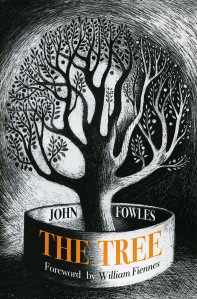 The Tree by John Fowles. Little Toller, 2016. A largely autobiographical essay by novelist Fowles, first published in 1979. A bit rambling, but with some interesting points about trees and nature. To be honest, I bought this for its stunning cover by Ed Kluz.
The Tree by John Fowles. Little Toller, 2016. A largely autobiographical essay by novelist Fowles, first published in 1979. A bit rambling, but with some interesting points about trees and nature. To be honest, I bought this for its stunning cover by Ed Kluz.
Ernest Gimson: Arts & Crafts Designer and Architect by Annette Carruthers, Mary Greensted, and Barley Roscoe. Yale University Press, 2019. The publisher’s blurb calls Gimson ‘a central figure in the British Arts & Crafts Movement’. I had never heard of him, but that’s my ignorance, now corrected. Christina and I have a good Arts and Crafts Movement library, to which this is an interesting addition though the text is repetitive.
We Are Not Amused: Victorian Views on Pronunciation as Told in the Pages of Punch by David Crystal. Bodleian Library, 2017. Rather more of language expert Crystal (not a bad thing) and less of Punch cartoons than I expected.
Tales from the Folly: A Rivers of London Short Story Collection by Ben Aaronovitch. JABberwocky Literary Agency, 2020. I’ve enjoyed Aaronovitch’s series since 2011, when the first novel, Rivers of London, introduced Metropolitan Police constable and apprentice wizard Peter Grant. Since then the books have become more complex and have branched out with new characters. Tales from the Folly (the Folly is the headquarters of the London ‘magic police’) fills in some of the gaps between and around the novels (or novellas).
What Abigail Did That Summer by Ben Aaronovitch. Gollancz, 2021. Speaking of Aaronovitch’s novellas, this one features teenager Abigail Kamara, junior apprentice wizard and fox-whisperer, who was introduced in the third novel, Whispers under Ground. The story fills a gap between Foxglove Summer and The Hanging Tree. I like Abigail, and Aaronovitch clearly does too.
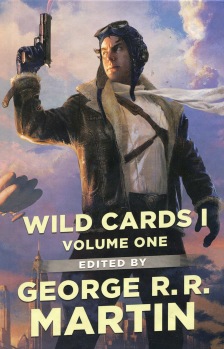 Wild Cards I, edited by George R.R. Martin. Tor, 2010 (I got the ‘mini-hardcover’, 2017). There was a short piece about this in a recent Locus which convinced me to give it a try. I had known about the series for some time and was intrigued by the concept (just after World War II, an alien virus mutates random survivors, giving some of them superpowers) but was reluctant to start, with more than two dozen ‘Wild Card’ volumes and counting. I don’t think I’ll continue with it. Since it’s a ‘shared universe’ with multiple authors contributing interconnected stories, the quality naturally varies, with some parts more exciting, or more tedious, than others. Of course, readers of genre fiction will think of fictional antecedents: Airboy comics, Alan Moore’s Watchmen, the Justice Society appearing before the House Un-American Activities Committee, etc.
Wild Cards I, edited by George R.R. Martin. Tor, 2010 (I got the ‘mini-hardcover’, 2017). There was a short piece about this in a recent Locus which convinced me to give it a try. I had known about the series for some time and was intrigued by the concept (just after World War II, an alien virus mutates random survivors, giving some of them superpowers) but was reluctant to start, with more than two dozen ‘Wild Card’ volumes and counting. I don’t think I’ll continue with it. Since it’s a ‘shared universe’ with multiple authors contributing interconnected stories, the quality naturally varies, with some parts more exciting, or more tedious, than others. Of course, readers of genre fiction will think of fictional antecedents: Airboy comics, Alan Moore’s Watchmen, the Justice Society appearing before the House Un-American Activities Committee, etc.
Designing English: Early Literature on the Page by Daniel Wakelin. Bodleian Library, 2018. Despite having worked with rare books for more than forty years, I learned a lot from Wakelin, and from his book’s many illustrations from the Bodleian’s superb collection of early English manuscripts. If I had to criticize this it would be for its design: long lines of text in a small size, and often very long paragraphs, all of which is wearying to the eye.
The Desolations of Devil’s Acre by Ransom Riggs. Dutton Books, 2021. The sixth and apparently last novel of Miss Peregrine’s Peculiar Children, unless Riggs goes for a third trilogy. This has been an inventive series, and like all stories with interesting characters one wants to read more of them, but the fiction has often seemed forced when Riggs invents incidents or traits to suit the strange antique photographs with which he illustrates his books, and it became overblown in the fifth novel, if not the fourth. The last has some blatant dei ex machina and ends on a pleasing but perhaps too sentimental note.
Later by Stephen King. Hard Case Crime, 2021. A semi-supernatural mystery – Jamie Conklin can speak with the dead – Later moves quickly. Although interesting, as King always tells a good story, I found it less satisfying than much longer books by him, such as The Stand.
Tolkien’s Modern Reading: Middle-earth beyond the Middle Ages by Holly Ordway. Word on Fire, 2021. Christina and I were sent a copy of this by the publisher, and have a separate review coming up in our blog.
Book Notes, January 2021
An advertising email received this morning from Pottery Barn asks: What are some creative ways to utilize wall space? Our answer, for the most part: bookcases! This is also our answer to the question of utilizing floor space.
Wayne writes: Not in any particular order, here are books I read during January:
Mystery Mile by Margery Allingham. Macfadden, 1967 printing (first published 1930). The first full Albert Campion mystery. Rather clumsy by today’s standards, and compared to some of the later Allinghams.
Merton College Library: An Illustrated History by Julia C. Walworth. Bodleian Library, 2020. An attractive book on the oldest library in continuous use at a university (Merton College, Oxford was founded in 1264). Christina and I did some work there when writing The J.R.R. Tolkien Companion and Guide.
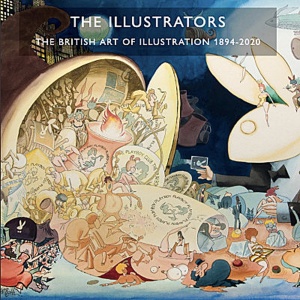 The Illustrators: The British Art of Illustration 1865–2019 and The Illustrators: The British Art of Illustration 1894–2020. Chris Beetles, 2019 and 2020. When we can, time and global pandemics permitting, we like to see the exhibitions at London art dealer Beetles, and as we have a keen interest in illustrations, we’ve picked up the mostly annual catalogues for Beetles’ Illustrators shows. Each is well written and has many good reproductions. These can also be read online, but well, we’re book collectors, so we have the physical volumes.
The Illustrators: The British Art of Illustration 1865–2019 and The Illustrators: The British Art of Illustration 1894–2020. Chris Beetles, 2019 and 2020. When we can, time and global pandemics permitting, we like to see the exhibitions at London art dealer Beetles, and as we have a keen interest in illustrations, we’ve picked up the mostly annual catalogues for Beetles’ Illustrators shows. Each is well written and has many good reproductions. These can also be read online, but well, we’re book collectors, so we have the physical volumes.
True to Life: British Realist Painting in the 1920s & 1930s by Patrick Elliott and Sacha Llewellyn. National Galleries of Scotland, 2017.
Evelyn de Morgan Oil Paintings. Compiled and edited by Catherine Gordon. De Morgan Foundation, 1996.
The Edwardians and Their Houses: The New Life of Old England by Timothy Brittain-Catlin. Lund Humphries, 2020. I bought this on the recommendation of a review in the Voysey Society journal, but expected it, despite the honest emphasis in the title, to have more on the houses and less on the Edwardians. ‘This book’, the blurb says, ‘is the first radical overview of the period since the 1970s, and focuses on how the leading circle of the Liberal Party, who built incessantly and at every scale, influenced the pattern of architecture across England.’ I did enjoy the section on the development at this time of magazines such as Country Life and Architectural Review.
Defending the Rock: How Gibraltar Defeated Hitler by Nicholas Rankin. Faber & Faber, 2017. Now here the title definitely misinforms. A good part of this unnecessarily thick book, entertainingly written though it is, deals with other events in World War II, only some of which are needed to treat to put the doings on Gibraltar in context; and Gibraltar didn’t defeat Hitler in the sense of direct, sustained resistance to attack. In fact, one of Hitler’s biggest blunders was that he didn’t take Gibraltar when he could (before he turned his sights on Russia), thus cutting off the Mediterranean to British support for Malta or Egypt.
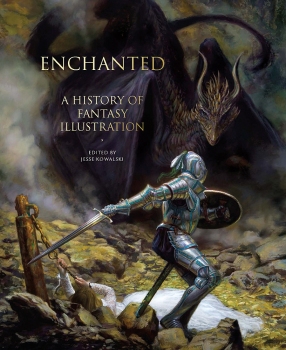 Enchanted: A History of Fantasy Illustration. Edited by Jesse Kowalski. Abbeville Press, 2020. Published for an exhibition scheduled for this summer at the Norman Rockwell Museum in Stockbridge, Mass. Christina and I were attracted to this book for obvious reasons, but were disappointed. It defines fantasy much too broadly, from fairy tales, mythology, and the Bible to Tarzan and Star Wars, much of the focus is narrowly on illustration of the late twentieth century, and the text is often on the level of Wikipedia. But it has many images I had not seen before.
Enchanted: A History of Fantasy Illustration. Edited by Jesse Kowalski. Abbeville Press, 2020. Published for an exhibition scheduled for this summer at the Norman Rockwell Museum in Stockbridge, Mass. Christina and I were attracted to this book for obvious reasons, but were disappointed. It defines fantasy much too broadly, from fairy tales, mythology, and the Bible to Tarzan and Star Wars, much of the focus is narrowly on illustration of the late twentieth century, and the text is often on the level of Wikipedia. But it has many images I had not seen before.
